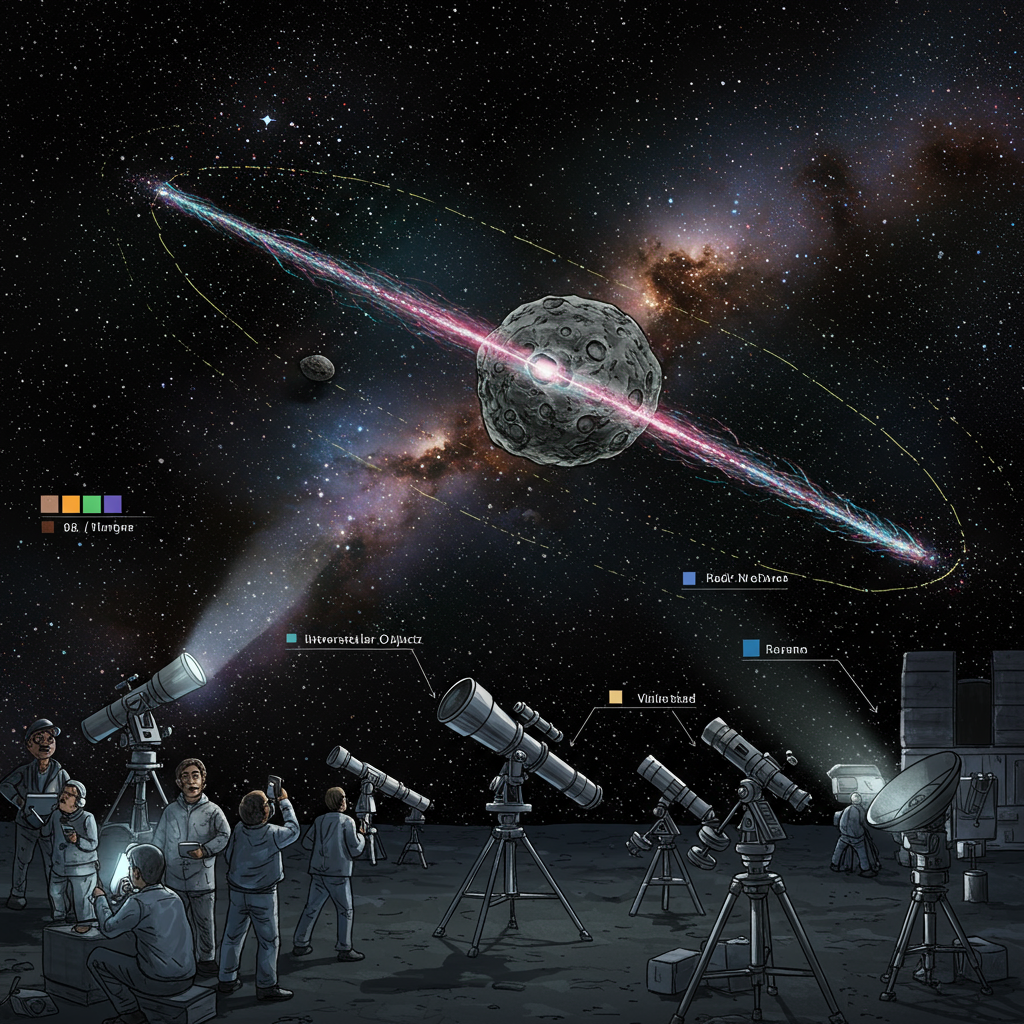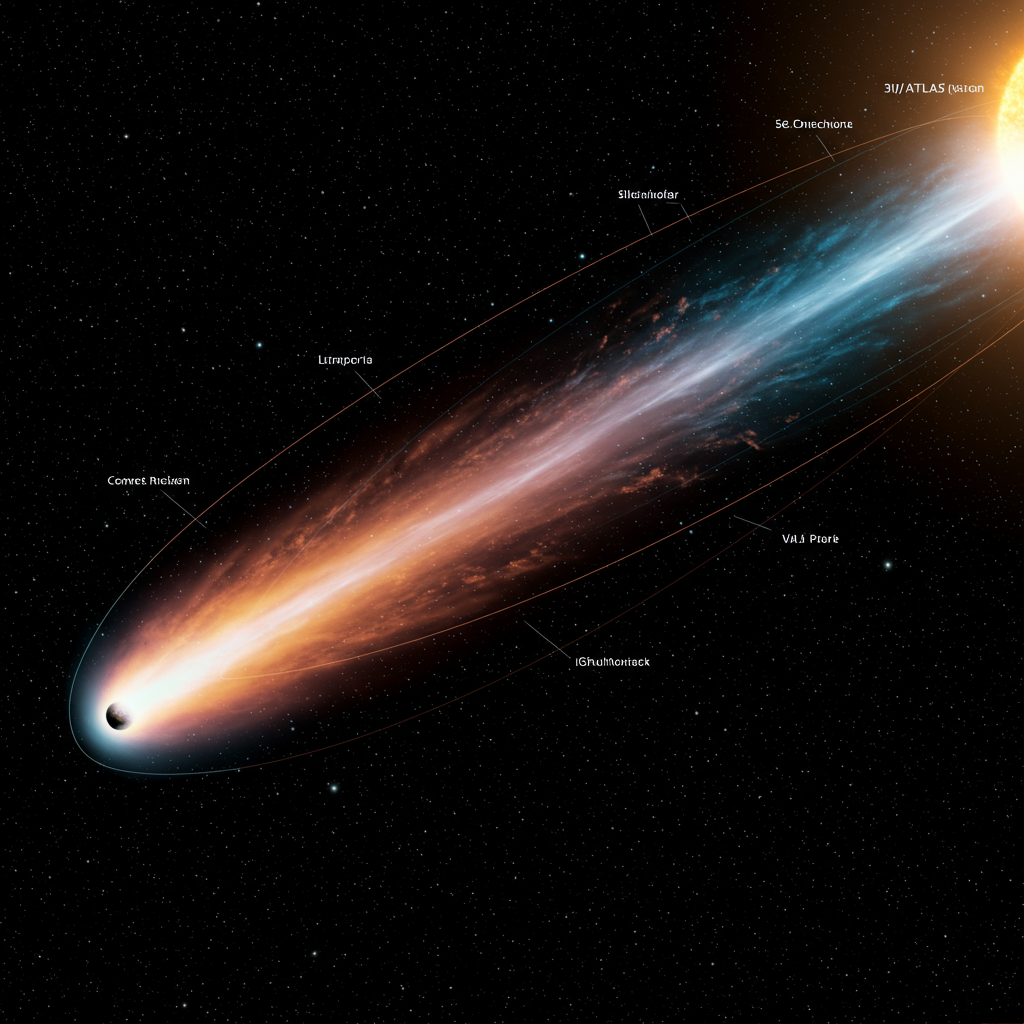Space is vast and full of surprises, but few discoveries excite astronomers as much as a visitor from another star system. Scientists are currently buzzing with excitement over a newly identified object, provisionally named A11pl3Z. This fast-moving celestial body appears to be only the third confirmed interstellar object ever detected passing through our solar system. Its unique journey is offering a rare glimpse into objects formed around distant stars, adding another piece to the cosmic puzzle. While it’s speeding towards the inner solar system, experts confirm it poses absolutely no threat to Earth.
Unveiling the Interstellar Candidate: A11pl3Z
The object, officially designated A11pl3Z, was initially spotted in late June by the Asteroid Terrestrial-impact Last Alert System (ATLAS) telescopes situated in Hawaii and South Africa. Its existence and initial characteristics were quickly confirmed by major astronomical bodies. NASA’s Center for Near Earth Object Studies (CNEOS) and the International Astronomical Union’s Minor Planet Center (IAU MPC) verified the data on July 1, 2025. The European Space Agency (ESA) has also officially announced its likely interstellar origins.
What Makes A11pl3Z Special?
The primary evidence pointing to A11pl3Z’s origin outside our solar system is its extreme speed and highly unusual trajectory. Objects originating within our solar system typically follow elliptical paths around the sun, influenced by its gravity. A11pl3Z, however, is on a hyperbolic trajectory.
This means it has so much velocity it will not be captured by the sun’s gravity. It possesses more than enough momentum to enter our solar system, loop around the sun, and head back out into interstellar space. Early data, including finding the object in older “precovery” images from the ATLAS telescope, refined this picture. The object’s orbital eccentricity is estimated at a remarkably high value, potentially around 10.4. An eccentricity value greater than 1 is a definitive indicator of an object that did not form within our sun’s gravitational sphere.
Its sheer speed is another giveaway. A11pl3Z has been measured traveling at speeds up to approximately 152,000 mph (245,000 km/h) relative to the sun. This kind of velocity is typical for objects that have been ejected from or originated far beyond stellar systems. Astrophysicists like Josep Trigo-Rodriguez support the interstellar hypothesis based on these clear orbital signatures.
A Rare Cosmic Visitor: Comparing A11pl3Z to Previous Finds
If confirmed, A11pl3Z would join a very exclusive club. Only two other objects have previously been confirmed to have originated from outside our solar system and passed through:
ʻOumuamua: Discovered in 2017, this object was the first identified interstellar visitor. It had a peculiar, elongated shape and initially sparked debate about its nature, including some speculation about artificial origins, although it is widely considered a natural phenomenon.
2I/Borisov: Found in 2019, this was the second confirmed interstellar object. Unlike ‘Oumuamua, it exhibited characteristics more typical of a comet, including a visible tail.
The potential discovery of A11pl3Z suggests these interstellar travelers might be more common than previously thought. It also highlights the increasing capability of modern astronomical surveys to detect these fast-moving, transient objects.
What We Know About A11pl3Z So Far
Initial observations are providing some clues, but many questions remain about A11pl3Z’s physical nature. Estimates of its size vary slightly between researchers, ranging from roughly 12 miles (20 kilometers) up to 25 miles (40 kilometers) in diameter. This suggests it is a significant object.
Scientists are not yet certain if it is primarily a rocky asteroid or an icy comet. Early images do not show an obvious cometary tail, but more detailed observations might reveal one. Its precise shape also remains unknown at this early stage.
The object is currently located hundreds of millions of miles away, positioned roughly inside the orbit of Jupiter. It is currently moving towards the inner solar system.
Tracking A11pl3Z’s Journey and Future Observations
A11pl3Z is on a path that will take it relatively close to some parts of our solar system. Its trajectory indicates it will make its first notable planetary close approach near Mars on October 3, 2025. Shortly after, it will reach its closest point to the sun, known as perihelion, around October 23, 2025. At perihelion, it is expected to be about 2 astronomical units (AU) from the sun, which is approximately twice the distance of Earth from the sun. Its speed relative to the sun at this point will be about 68 km/s.
It is absolutely crucial to note that while A11pl3Z is listed as a “near-Earth object candidate” due to classification parameters, its path poses no threat to our planet. During its closest approach to the sun in October, Earth will be located on the opposite side of the sun. The object is expected to make its closest approach to Earth much later, in December 2025, as it travels back out of the solar system, passing at a safe distance.
Astronomers worldwide are now focusing telescopes on A11pl3Z. They plan to conduct intense study in the coming weeks and months. The goal is to gather as much data as possible to confirm its origin definitively and learn more about its composition, size, and shape.
Improved observational capabilities compared to the discoveries of ‘Oumuamua and Borisov mean scientists have better tools available. New observatories like the Vera C. Rubin Observatory, designed specifically to detect moving objects, are expected to contribute valuable data. There are even proposals to potentially use NASA’s Mars rovers to attempt capturing images during its pass by the Red Planet. Some researchers are even suggesting using powerful instruments like the James Webb Space Telescope to search for subtle signs of non-gravitational acceleration, which could hint at unusual properties or even propulsion, though this is highly speculative for a natural object.
The discovery of A11pl3Z is a testament to the advancements in astronomical surveys. It marks the exciting beginning of a period of intense observation and analysis. Scientists are eager to unlock the secrets this visitor from another star system holds.
Frequently Asked Questions
What makes A11pl3Z likely an object from outside our solar system?
Astronomers believe A11pl3Z is interstellar mainly because of its extreme speed and trajectory. It’s traveling on a hyperbolic path, meaning it has enough velocity to escape the sun’s gravity. Its orbital eccentricity is exceptionally high (around 10.4), which is a strong indicator it didn’t originate within our sun’s gravitational influence. Its measured speed is also very high, around 152,000 mph relative to the sun.
How are astronomers studying A11pl3Z and what do they hope to learn?
Astronomers globally are using various telescopes to observe A11pl3Z intensely. They are collecting data to precisely determine its orbit, size (estimated 12-25 miles wide), composition (rocky or icy?), and shape. They also hope to use advanced instruments like the James Webb Space Telescope and potentially even Mars rovers to gather detailed information and confirm its nature as an interstellar visitor.
Should we be concerned about A11pl3Z hitting Earth?
No, there is no danger of A11pl3Z hitting Earth. Scientists have precisely calculated its trajectory. While it will pass near Mars in October 2025 and reach its closest point to the sun shortly after, Earth will be safely on the opposite side of the sun during these passes. It will make a closest approach to Earth later in December 2025 as it leaves the solar system, but at a very safe distance.
Conclusion
The potential identification of A11pl3Z as the third known interstellar object passing through our solar system is a significant astronomical event. Its extreme speed and hyperbolic orbit leave little doubt for many experts that it originated from another star system entirely. While much remains unknown about its physical characteristics – whether it’s a rock or ice, its exact size or shape – astronomers are rapidly mobilizing resources worldwide to study this rare visitor. This discovery underscores the increasing efficiency of our cosmic detection systems and promises to yield valuable insights into objects formed in distant stellar environments. Scientists will continue to track A11pl3Z closely as it makes its journey through our cosmic neighborhood, hoping to unlock its secrets before it heads back into the depths of interstellar space.




